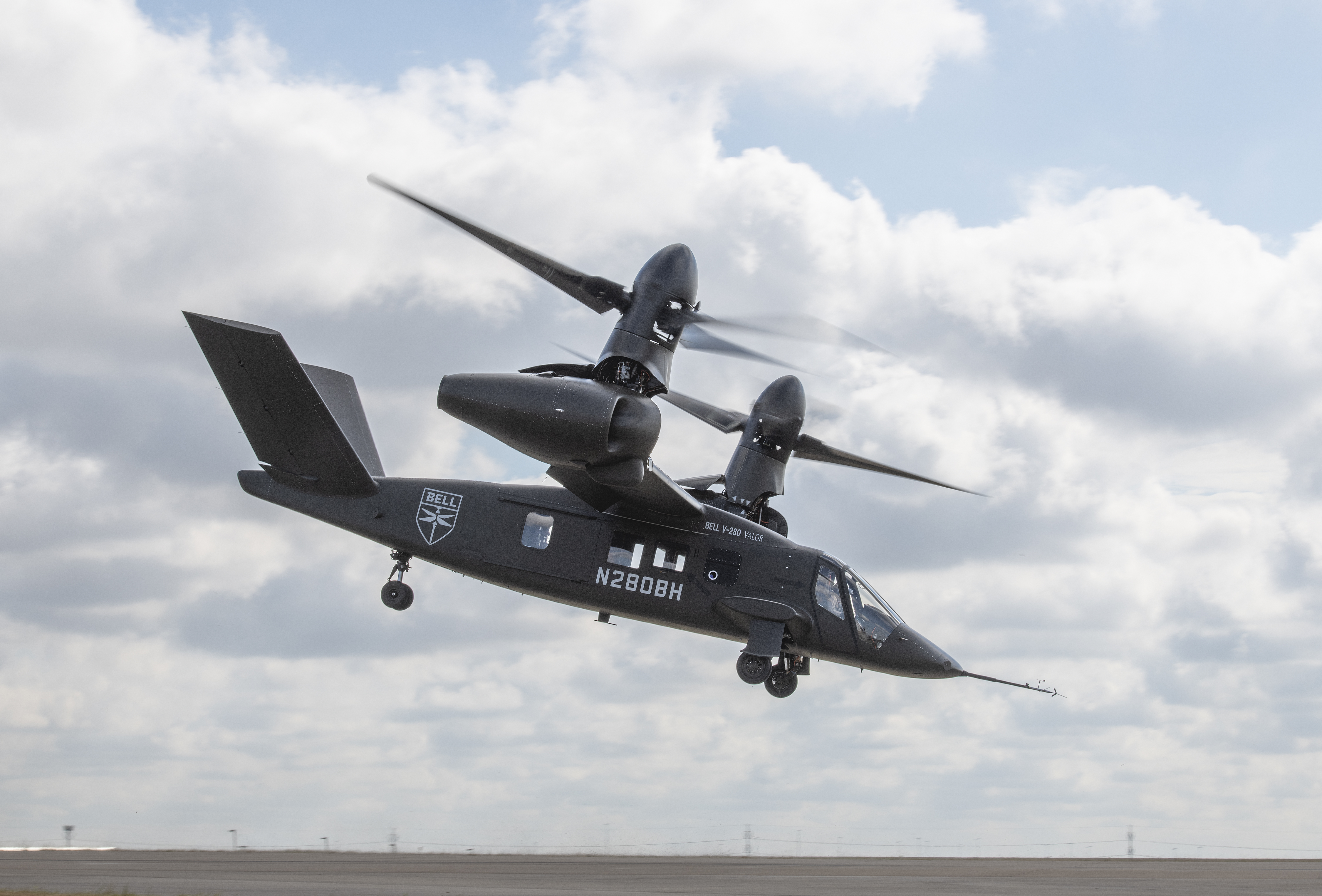
The Bell V-280 has the maneuverability, speed, and range to create and capitalize on tactical opportunities.
To counter Great Power competitors, the Army must operate in highly contested/complex airspace and degraded environments against adversaries with advanced integrated air defense systems. The Army is depending on the development of two new vertical-lift aircraft weapons systems to help meet this threat. In this discussion with Carl Coffman, vice president, Future Vertical Lift Strategy at Bell, we discuss how the Bell V-280 Valor and Bell 360 Invictus meet the requirements of the Army’s Future Long-Range Assault Aircraft (FLRAA) and Future Attack Reconnaissance Aircraft (FARA), respectively.
Breaking Defense: The Army conceived of Future Vertical Lift (FVL) during a time when the U.S. military was focused primarily on violent extremist organizations. As the threat shifts to the Great Power competition against China and Russia, what role does FVL play now?
Coffman: Modern warfare is a range competition, upgraded defenses aid in creating standoff. It’s like a prize fight where the boxer with the longest reach has an advantage. With the increased ranges, ISR capability, and network systems of our competitors, we’re at a condition of near-parity when it comes to our capabilities and potential threats facing the military.
The Army has made it clear our forces need to regain overmatch. We’ve got to take a leap ahead with new capabilities so that we can achieve overmatch. It’s only through overmatch that we can achieve success in Joint All-Domain Operations, by deterring a fight and returning to a competitive state, managing a crisis and preventing the fait accompli, and then winning a conflict if and when necessary. Revolutionary FVL solutions are a capability required to stay in the crisis management phase, as the Army refers to it, and prevent the evolution into a full-scale conflict.
The Army must remain the premier global land component force. To do so, it will be required to maneuver ground forces across extended ranges and over various domains while being networked with the joint services. Whether you’re moving over water in the Pacific, over harsh environments in the Arctic, or over extended ranges in Eastern Europe and Africa, you’re going to be required to overcome and exploit the tyranny of distance and terrain. The Future Long-Range Assault Aircraft gives you that capability; keep in mind, these missions are not attainable using current Army aircraft.
Breaking Defense: What role will FLRAA play in Joint All-Domain Operations.
Coffman: FLRAA is not a direct replacement for our current fleet of H-60 helicopters – it is a leap ahead into an entirely new capability space for the Army. H-60s are great aircraft. They’ve served the Army and Navy well. But it’s time to move on from traditional helicopter technologies because you can’t push a traditional helicopter through the air at the speeds, ranges and with the endurance you need for long-range assault aircraft to fulfill their missions. You have to be able to take advantage of dilemmas created by long-range precision fires or cyber/EW attacks. The V-280 for example, is able to penetrate an anti-access/area denial (A2AD) environment and reposition a ground-maneuver force over 200 nautical miles at a speed that allows you to take advantage of dilemmas that you’ve created for the enemy.
Reaction time and maneuver space are your fundamental challenges for a ground-force commander, and it’s going to be a bigger challenge in the future. Speed and range are the answers to those challenges, or significant contributors to the Joint Force overcoming those challenges. That’s one of the critical advantages that the V-280 provides. Once you determine you have an opportunity, or you create an opportunity, you’ve got to be able to capitalize on it. Maneuverability, speed, and range where it matters – across the entire mission profile – are what give you the agility to capitalize on battlefield opportunities.
Once you get to an objective area, you’ve got to locate, engage, and provide networking capabilities for targeting. The goal is to initiate and/or impact rapid progression through the kill chain to put both effective fires on target and ground forces on an objective.
Breaking Defense: How does FVL interact and build upon the five other Army modernization priorities – long range precision fires, next-generation combat vehicles, network modernization, air and missile defense, and soldier lethality?
Coffman: They’re absolutely all connected. You’ve got to have a responsive fires capability. You need to be able to target those long-range fires using the next generation speed and range capability of the Future Attack Reconnaissance Aircraft. You’ve got to be able to quickly reposition a ground maneuver force anywhere in a region to deliver or threaten delivery of direct and indirect fires. All these pieces must work cohesively in an environment that’s networked. The Army has been clear that it needs modern systems to exhibit speed, range, and convergence to achieve their goals. The Army breaks it down very simply at the tactical level: you must be able to move, communicate, and shoot while informing your Joint Force partners of your location.
In order to capitalize on our joint force and our combined arms fight capabilities, everything needs to be networked so things are deconflicted. That needs to happen at a rate that’s much more rapid than we’ve ever seen in the past. To stay ahead in the decision cycle, in order to compete and deter, and win once you get to conflict, that networked environment is critical.
That’s not just networked within the ground-maneuver force, it includes connection to next-gen combat vehicles and long-range precision fires. It’s also knowing where your air defense capabilities are, especially those operating in a lower-tier air domain. They have to know where you are and what you’re doing. That’s not just in the Army, but across the services. That allows joint force capabilities to converge at the right time, at the right place.
Breaking Defense: Is there something specific about the technologies that you’ve chosen for the V-280 such as tiltrotor technology, for example, that make it better suited to Big Army needs and multi-domain operations?
Coffman: Take a look at what the Army is asking for from the long-range assault aircraft and for the attack reconnaissance aircraft. For FARA, you want the ability to move very quickly over long distances, and you want to have a significant amount of endurance in the objective area while you’re out there conducting reconnaissance. That’s an endurance-heavy event.
For FLRAA, it is about long range or reach…range and speed. That extends well-beyond the capability of the current assault aircraft. Bell is the premier vertical-lift company in the world, and our assessment and experience determined that the optimal technology for the Army’s FLRAA requirements is the tiltrotor. We determined an optimized single-main-rotor helicopter with a lift offset wing is the most effective solution to meet the specific FARA requirements.
There is more to it than that of course. An open systems architecture is of paramount importance, as well, and the combination of that foundational and proven air vehicle performance with a digital backbone that enables mission system convergence in JADO is really the key.
What we’re not doing is taking a technology and applying it to a problem where it really doesn’t fit. We don’t have a solution that’s looking for a problem. We’ve taken the Army requirements and developed solutions based on operational experience and engineering analysis. Bell assessed several technologies, including coaxial solutions, and determined that based on the complexity, technical maturity, cost and weight of the drive and rotor system, and the impacts on sustainability, in addition to the speed, range, and endurance requirements, it wasn’t the best value solution for the FLRAA or the FARA mission. That’s why we chose the specific aircraft designs that we did.
Compared to the development of competing technologies, for example, we’ve flown more test flight time on one V-280 tiltrotor demonstrator in three years than the combination of all the previous coaxial tech demonstrators or prototype efforts combined over the last two decades. We’re over 214 hours of flight time on the V-280, not to mention being informed by over 600,000 hours of operational time on the battle-proven V-22. We didn’t see the need to reinvent the wheel for FLRAA and ultimately develop something slower and with shorter range than a technology already in operation by the Marine Corps, Air Force, and Navy. But, we did want to capture lessons learned in what is a second-generation, clean-sheet aircraft designed to the Army requirements. We wanted to enter the FLRAA program with a flight-proven air vehicle capability backed up by validated digital models and demonstrated reliability. We demonstrated that we are there with the V-280 and we got there on schedule.
The Bell 360 Invictus, our FARA candidate, is based on the Bell 525 Relentless. We pulled a lot of lessons learned out of the advanced technology of the 525. It is on track to be the first fly-by-wire commercial helicopter and has an optimally designed main rotor and drive system informed by more than 1,900 hours of flight time.
The bottom line: when you achieve the agility, speed, range, and endurance, and you need the ability to sustain an aircraft over an extended maintenance-free operating period in an austere environment, the coaxial aircraft is just not optimized for that life-cycle affordability consideration.
One of the words that keeps coming up to me is ‘efficiency.’ One of the reasons that we have a lot of confidence in the reliability of our aircraft is the reduced complexity and higher efficiency that you get from the engineering that we’ve put into both the V-280 Valor and the Bell 360 Invictus. Reduced complexity in the aircraft matters over its lifecycle in terms of sustainability, supporting readiness goals, and meeting cost targets.
The high-maintenance and cost drivers on rotorcraft are drive systems, rotor blades (the V-280 is a 6-blade design), and flight-control software. You want to be able to control and manage those high-maintenance drivers, and at Bell we retain that work in-house. Ultimately, we are responsible for the quality of our delivered weapon system. We manage other components of the aircraft through premier supplier relationships, but those key dynamic systems stay with us. We keep that core competency in-house at Bell because we want to be able to ensure that we are being responsive and meeting customer needs for readiness and costs typically driven by rotorcraft dynamic components.
Breaking Defense: Final thoughts?
Coffman: The bottom line is the Future Long-Range Assault and Attack Reconnaissance Aircraft are going to be a joint force requirement in the future fight. We cannot continue to evolve current capability but rather need a revolution in capability. We have to have a leap ahead in the speed, range, and endurance capability of our systems or we’re never going to achieve overmatch, which then significantly reduces our ability to compete, and reduces our capability to manage crisis, and any potential conflict if it gets to that point.
And how does it get to conflict? When the threat is bold enough to realize that you have not deterred them. They’re not concerned about your capability. When you get to crises, you fail in your ability to manage it because you don’t have the capability to prevail.
To prevent that eventuality, the Army has already made a significant investment in the FVL programs and the V-280 and Bell 360 Invictus through the previous work that’s been done. Now is the opportunity for the Army to maintain momentum in its modernization effort with the lowest-risk programs that will quickly get this revolutionary capability fielded to the soldier.






















